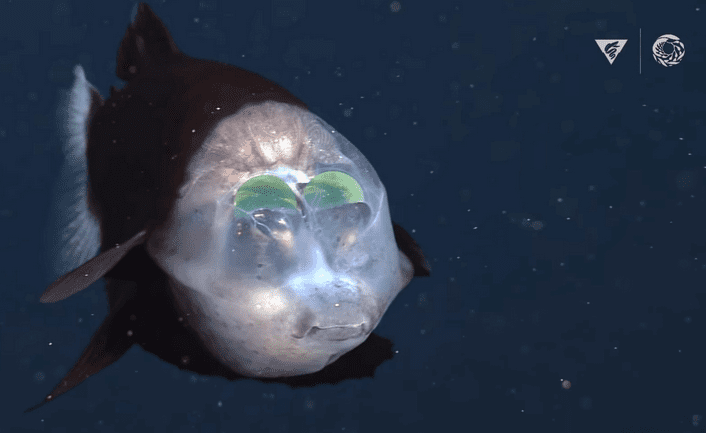As the name suggests, Pacific barreleye fish may not be the most striking creatures in the sea, but don’t let their unassuming appearance fool you. These fish have some truly remarkable features that make them stand out from their marine counterparts. So, let’s dive in and explore some cool facts about these species!
Phylum: Chordata
Class: Actinopterygii
Order: Argentiniformes
Family: Opisthoproctidae
Genus: Macropinna
1. They have a transparent head
The Pacific barreleye fish is truly a remarkably weirdest animal in the world. Upon first glance, you may think it is kind of something out of a science fiction movie.
This deep-ocean dweller belongs to the family Opisthoproctidae in the order Argentiniformes, which comprises over 228 distinct species. Among them, the Pacific barreleye could be one the most outstanding barreleye fish species of all.

What sets this fish apart is its peculiar transparent dome, which encloses a fluid-filled area from the mouth to the top of its head. This gives it a distinct submarine impression. Through this special dome, the brain, eyes, and even nerve endings in their head can be observed. It’s similar to the way you can see all the organs of the glass frog through its transparent belly.
However, this remarkable characteristic is damaged whenever the barrel-eye fish are brought up from the depth out of water. It becomes a gooey mess due to the sudden change in pressure, just like the blobfish.
In contrast to the distinctive head, its body is brown and unremarkable. It possesses a small mouth and a pointed snout. The fish barely reach a size of six inches (15 cm) in length when fully grown.
Despite their unique eyes, the Pacific barreleyes fish are often mistaken to have eyes above their mouth. However, these are their oval-shaped olfactory organs which are similar to our nostrils.
2. Their eyes are unlike any other species
Not only do Pacific barreleye fish have special head, but they also own very distinctive eyes. They possess tubular eyes that can look both straight ahead and directly upward at a 90o angle.
This provides them with an exceptional field of vision. In fact, they have more than just tunnel vision and are capable of seeing almost everything surrounding them. Can you see how incredible their eyes are?

And if this is not enough to wow you, let’s check it out! When looking for prey, these barreleyes can rotate their eyes forward.
Their green eyes may aid in filtering out green waves from surface light. This allows them to perceive bioluminescence in jellyfish and other deep-sea species.
3. Habitat
The Pacific barreleye fish are predominantly found in the offshore waters of California and the North Pacific Ocean. They typically reside at depths ranging from 2,000 to 2,600 feet (600-800 meters), where they can’t get sunlight.
In this lightless environment, the species can only detect and distinguish light sources from above and from their potential prey.
4. They live a dark and lonely life
Barreleye fish are known for their sedentary lifestyle, as they prefer to float in the ocean and maintain their position for most of their lives. With a pair of big, flat pectoral fins, the fish can remain stationary and immobile in the water column, as well as move very cautiously and accurately.
The Pacific barreleyes put more effort only when swimming around colonial jellies, also known as siphonophores, to take their food. These jellies can reach lengths of up to 10 meters (33 feet) and act as massive living fishing nets, catching food by using thousands of their stinging tentacles.

The fish just need to follow these big jellies, use their extraordinary eyesight to avoid the siphonophore’s lethal sting and consume anything (copepods, hydroids, and other small crustaceans) they leave behind.
These barreleyes live their entire lives alone, drifting through the vast depths of the ocean. They also do not engage in social interaction.
5. They steal food
Pacific barreleye fish have a diverse diet, consisting of siphonophores, crustaceans, zooplankton, and small jellies. Their lengthy digestive system enables them to break down various types of prey.
To hunt food, the Pacific barreleye fish use an ambush tactic. They remain stationary while looking upward with their eyes. Despite living in complete darkness, they can still find exactly their food with their incredibly sensitive eyes.

Those eyes are shielded by a green filter that blocks out light from the sea’s surface, making it easier to spot the glowing jellies swimming above them. Once they find their prey, they quickly swim upward to capture it.
As mentioned above, the barreleyes also stay below the siphonophores to get their spare food. They also steal food from the jellies using their mouth. This is dangerous because they can get stung anytime. The fish know this! That’s why they have a translucent dome feature to protect their eyes.
6. Life cycle
The barreleyes release their fertilized eggs into the water. The eggs hatch and their larvae float at shallow depths. As the larvae develop, they transform and move down into the deeper sea, where they eat zooplankton and small organic particles.
The lifespan of Pacific barreleye fish remains uncertain.
7. Conservation status
Although Pacific barreleye fish are rare, they are not endangered species. However, they still face threats from human activities such as climate change, environmental encroachment, contamination, or coastal erosion. These factors can impact their habitat and food sources, potentially leading to population declines in the future.
Fortunately, these creatures are not hunted commercially, and their deep-sea habitat makes them less susceptible to bycatch.
References:

